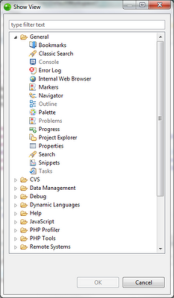Tips and Tricks of coding with Zend Studio for Eclipse – Part 2
May 11, 2011 Leave a comment
Join Peter MacIntyre for a special webinar on ‘Tips and Tricks coding with Zend Studio for Eclipse – Part 2′. The participants can greatly benefit from this webinar by learning the key Zend concepts & features including Views, Perspectives and basic area of coding environment.
Zend Studio for Eclipse is the premier coding environment for PHP. With multiple integration points, features, and tools the modern PHP developer needs to know how to use this product for efficient coding. In this webinar Peter will cover the basic areas of the coding environment, spending most of the time on the PHP Perspective.
Register Now by Clicking at the link below:
Monday, June 27, 2011 at 2 PM BST
Monday, June 27, 2011 at 12:30pm EST
Duration: 1 hour
What You Will Learn?
In the second part of webinar, Peter will cover the following topics:
- PHPDoc tag entries
- Connecting dependent projects (Configuring projects)
- Function definitions in content assist
- Using the Properties view to full effect
- Using PHPDoc tags for documentation
- PHP Code Gallery
- Working Sets
More Preferences settings:
- Key Mapping
- Code Analyzer
- Code Assist settings
- Cursor Hovering feature
- Settings in the Tasks view
- Code Templates
About Peter MacIntyre:
Peter MacIntyre has over 20 years of experience in the information technology industry, primarily in the area of software development. He is certified by ZEND Corporation on PHP 4.x and has contributed writing material for Using Visual Objects (Que Corp.), Using PowerBuilder 5 (Que Corp.), ASP.NET Bible (Wiley Pub.), and Web Warrior Survey on Web Development Languages (Course Technology). Most recently he has co-authored the Zend Studio for Eclipse Developer’s Guide – Addison-Wesley.
Peter is a PHP Programmer, author, consultant and trainer and lives in Charlottetown, Prince Edward Island, Canada. He is Senior Solutions Consultant with Zend Center of Excellence at OSSCube.
About OSSCube:
OSSCube is proud to be consistently rated as one of the best PHP Solutions companies in the world. Simply speaking..“If Its PHP we do it Best !”. OSSCube is also the world’s first Zend Center of Excellence, housing best of breed PHP expertise and development practices, which has established us as a “preferred partner” for Outsourced Product Development engagements. Our partnerships with leading open source technology/product provider including Acquia (Drupal), SugarCRM (Gold Partner), and EnterpriseDB (Global SI Partner) empower us to deliver innovative, on time and cost effective open source solutions to business globally through our delivery centers in USA, UK and India. Learn more at php.osscube.com
